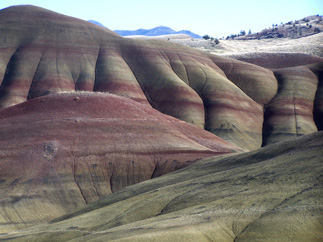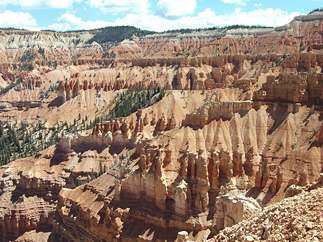

Horizontal rock layers are beautifully exhibited at the Painted Hills Unit of John Day Fossil Beds National Monument in Oregon and at Cedar Breaks National Park in Utah.
About the geologic time scale
Origins of a geologic time scale
The first people who needed to understand the geological relationships of different rock units were miners. Mining had been of commercial interest since at least the days of the Romans, but it wasn't until the 1500s and 1600s that these efforts produced an interest in local rock relationships.
By noting the relationships of different rock units, Nicolaus Steno in 1669 described two basic geologic principles. The first stated that sedimentary rocks are laid down in a horizontal manner, and the second stated that younger rock units were deposited on top of older rock units. To envision this latter principle think of the layers of paint on a wall. The oldest layer was put on first and is at the bottom, while the newest layer is at the top. An additional concept was introduced by James Hutton in 1795, and later emphasized by Charles Lyell in the early 1800s. This was the idea that natural geologic processes were uniform in frequency and magnitude throughout time, an idea known as the "principle of uniformitarianism."
 |
 |
|
Horizontal rock layers are beautifully exhibited at the Painted Hills Unit of John Day Fossil Beds National Monument in Oregon and at Cedar Breaks National Park in Utah. |
||
Steno's principles allowed workers in the 1600s and early 1700s to begin to recognize rock successions. However, because rocks were locally described by color, texture, or even smell, comparisons between rock sequences of different areas were often not possible. Fossils provided the opportunity for workers to correlate between geographically distinct areas. This contribution was possible because fossils are found over wide regions of the Earth's crust.
For the next major contribution to the geologic time scale we turn to William Smith, a surveyor, canal builder, and amateur geologist from England. In 1815 Smith produced a geologic map of England in which he successfully demonstrated the validity of the principle of faunal succession. This principle simply stated that fossils are found in rocks in a very definite order. This principle led others that followed to use fossils to define increments within a relative time scale.
About the geologic time scale divisions
The geologic history of the Earth is broken up into hierarchical chunks of time. From largest to smallest, this hierarchy includes eons, eras, periods, epochs, and ages. All of these are displayed in the portion of the geologic time scale shown below.
| Eon | Era | Period | Epoch | Age |
| Phanerozoic | Cenozoic | Paleogene | Oligocene | Chattian |
| Rupelian |
The Phanerozoic Eon represents the time during which the majority of macroscopic organisms — algae, fungi, plants and animals — lived. When first proposed as a division of geologic time, the beginning of the Phanerozoic (542.0 million years ago)* was thought to coincide with the beginning of life. In reality, this eon coincides with the appearance of animals that evolved external skeletons, like shells, and the somewhat later animals that formed internal skeletons, such as the bony elements of vertebrates. The time before the Phanerozoic is usually referred to as the Precambrian and is usually divided into the three eons shown.
The Phanerozoic is subdivided into three major divisions: the Cenozoic, Mesozoic, and Paleozoic Eras. The "-zoic" suffix comes from the root "zoo," which means animal. This is the same root as in the words zoology and zoological park (or zoo). "Cen-" means recent, "Meso-" means middle, and "Paleo-" means ancient. These divisions reflect major changes in the composition of ancient faunas, each era being recognized by its domination by a particular group of animals. The Cenozoic has sometimes been called the "Age of Mammals," the Mesozoic the "Age of Dinosaurs," and the Paleozoic the "Age of Fishes." But this is an overly simplified view, which has some value for the newcomer but can be a bit misleading. For instance, other groups of animals lived during the Mesozoic. In addition to the dinosaurs, animals such as mammals, turtles, crocodiles, frogs, and countless varieties of insects also lived on land. Additionally, there were many kinds of plants living in the past that no longer live today. Ancient floras went through great changes too, and not always at the same times that the animal groups changed.
References and resources
Anthony R. Fiorillo posted the original geologic time pages, 12/13/1993; P. David Polly added the geologic time chart graphics, 12/6/1993; Allen G. Collins added the time machine (geologic time chart) page, 11/26/1994; Brian R. Speer rewrote text and added a new chart of geological eras, 3/08/1997; Colleen Whitney constructed a new introductory page, 5/2000; Dave Smith made modifications to the introductory page and added a new banner graphic, 7/7/2000; Dave Smith applied the new page format, made a new time machine table, 5/26/2011; Painted Hills photo by Ivo Duijnstee; Cedar Breaks photo by Dave Smith